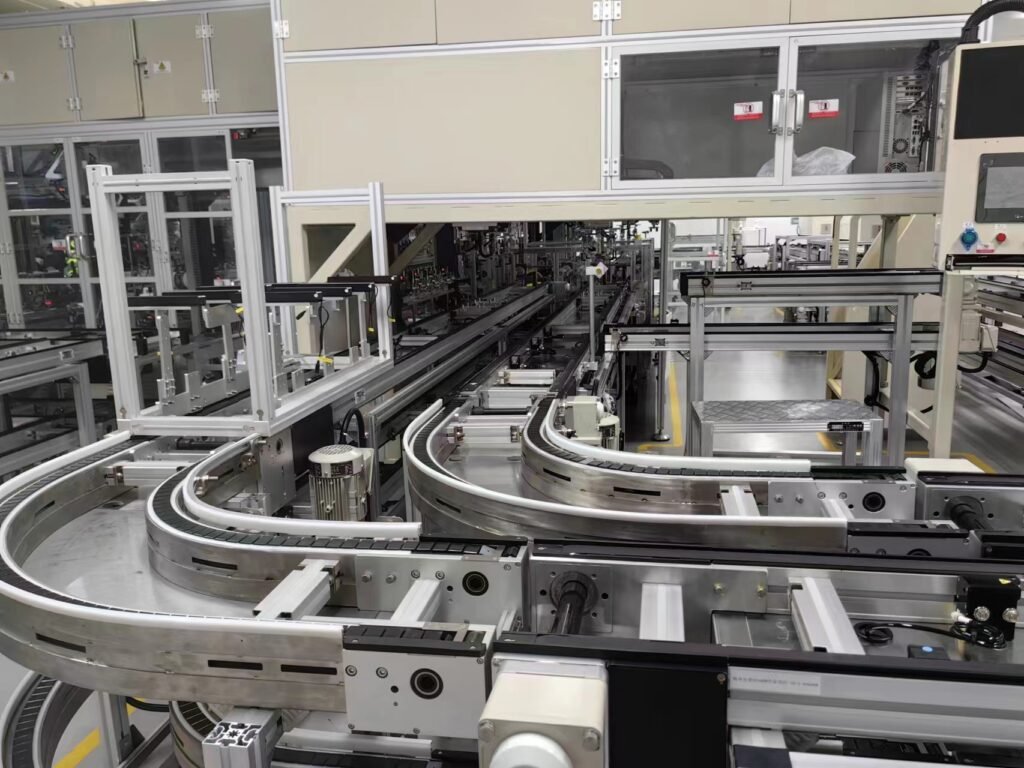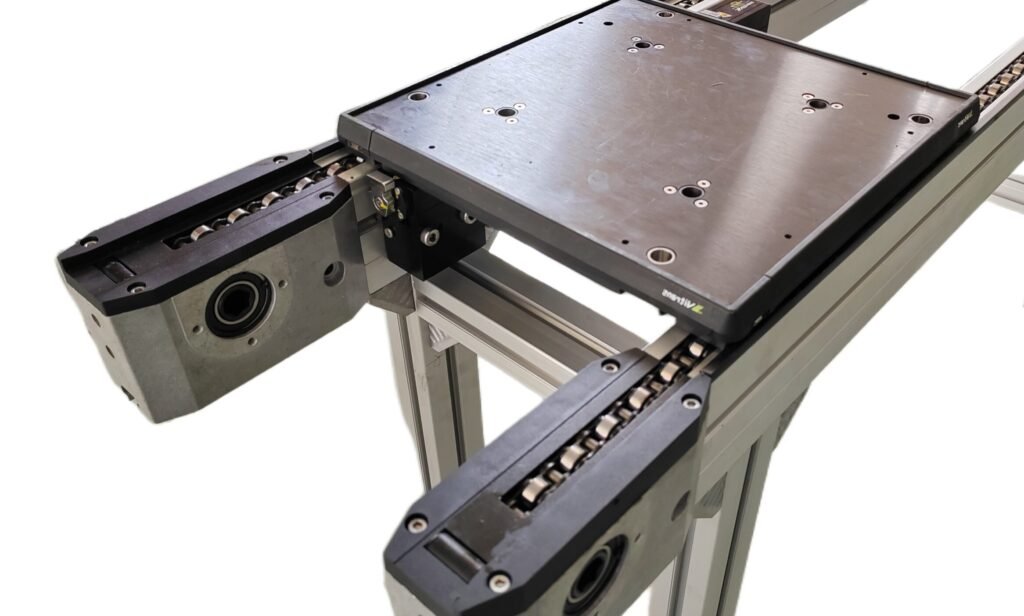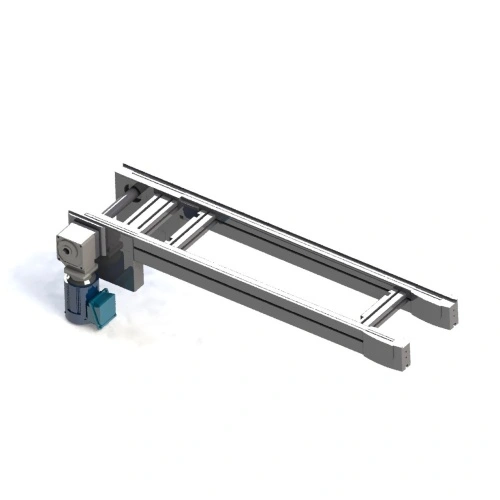Conveyor belt systems are essential components in various industries, streamlining processes and increasing efficiency. From packaging to assembly lines, these systems allow for seamless material handling. The global demand for conveyor belt systems is constantly growing as businesses seek to optimize operations and enhance productivity.
In this article, we’ll explore the most common types of conveyor belt systems, their applications, and the advantages they offer. We will also highlight some of the top products offered by Vitrans, a leading manufacturer of conveyor systems, and provide answers to frequently asked questions.
What is a Conveyor Belt System?

A conveyor belt system is a mechanical device used to transport materials from one location to another. It consists of two or more pulleys (also known as drums) with a loop of a conveyor belt that rotates around them. Conveyor belts are widely used in various industries like manufacturing, logistics, warehousing, and more.
Common Types of Conveyor Belt Systems
Conveyor systems are designed to meet the needs of specific industries and can vary in size, functionality, and material. Below are some of the most common types of conveyor belt systems available today:
1. Belt Conveyor Systems

Bandförderer are the most common type of conveyor system, typically used in material handling and automated production lines. They feature a continuous loop of rubber or synthetic material that rotates around two or more pulleys.
Anwendungen:
- Packaging lines
- Food processing
- Assembly lines
- Airports for luggage handling
Advantages:
- Cost-effective
- Simple to operate
- Can handle a variety of materials
2. Pallet Conveyor Systems
Pallet conveyors are designed for the transportation of heavy-duty products, such as pallets, between production stations. They are robust systems used in warehousing, manufacturing, and distribution.

Products by Vitrans:
- Gurtpalettenförderer
- Staukettenförderer
- Anbaugeräte-Förderer
Advantages:
- Ideal for heavy loads
- Durable and efficient
- Suitable for long-distance material transport
3. Roller Conveyor Systems
Roller conveyors are widely used for moving bulk materials or products along flat surfaces. They use a series of cylindrical rollers that rotate and help move the items across the conveyor.
Anwendungen:
- Warehousing
- Assembly lines
- Packaging lines
Advantages:
- Reduced energy consumption
- High load-bearing capacity
- Minimal maintenance
4. Chain Conveyor Systems

Kettenförderer use a series of chains to move products. They are often used in the automotive and industrial sectors where heavy materials need to be moved along assembly lines.
Vitrans’ Product:
- Staukettenförderer
Advantages:
- Suitable for moving heavy items
- Great for harsh environments
- Can handle uneven surfaces
5. Modular Belt Conveyors
Modular belt conveyors are made of interlocking segments or modules. These segments can be replaced individually, which makes the system more adaptable and cost-effective.
Anwendungen:
- Food processing
- Pharmaceuticals
- Verpackung
Advantages:
- Easy maintenance
- Customizable
- Suitable for hygienic environments
6. Product Transfer Conveyor
Product transfer conveyors are used to move items between different sections of a conveyor system. They ensure smooth transitions, reducing the risk of product damage.
Vitrans’ Product:
- Produkt-Transfer-Förderer
Anwendungen:
- Automated production lines
- Assembly lines
- Material handling in warehouses
Advantages:
- Precision in handling
- Reduces product loss
- Increases production efficiency
Key Factors to Consider When Choosing a Conveyor Belt System
When choosing the right conveyor belt system for your business, it’s important to consider several factors. Each type of system is designed for specific needs, so here are some key aspects to keep in mind:
1. Load Capacity
Choose a conveyor system that can handle the weight of your products. For instance, a pallet conveyor system is ideal for heavy loads, while a belt conveyor system is suited for lightweight materials.
2. Material of the Belt
The type of material the conveyor belt is made of will depend on the nature of your product. For example, a food-grade belt made of stainless steel or plastic is essential in the food industry to ensure hygiene.
3. Speed and Efficiency
Consider how fast your conveyor system needs to operate to keep up with production. High-speed belt systems are ideal for fast-moving assembly lines, while slower speeds may be suitable for more delicate products.
4. Maintenance Requirements
Systems that are easy to maintain reduce downtime and save costs. Modular belt conveyors, for example, allow for individual parts to be replaced, making them a great low-maintenance option.
5. Space and Layout
The size and layout of your workspace will determine the type of conveyor belt system you can install. Overhead and vertical conveyors are ideal for saving floor space in smaller warehouses.
Vitrans: A Leading Manufacturer of Conveyor Systems
Vitrans has been a leading manufacturer in pallet conveyors and pallet transfer systems for over 10 years. Their conveyor belt systems are widely used in various industrial automated production and assembly lines. Here’s why Vitrans stands out:
- High-Quality Manufacturing: Vitrans uses premium materials and advanced technology to produce durable and efficient conveyor systems.
- Wide Range of Products: From belt pallet conveyors to product transfer conveyors, Vitrans has a solution for all types of industries.
- Global Exporting: Vitrans’ conveyor systems are exported worldwide, offering competitive pricing and short lead times.
Vitrans’ Top Products:
- Gurtpalettenförderer
- Staukettenförderer
- Anbaugeräte-Förderer
- Produkt-Transfer-Förderer
With a strong supply chain in China, Vitrans provides high-quality systems at competitive prices, making them a preferred choice for businesses across the globe.
Advantages of Conveyor Belt Systems
Conveyor belt systems offer numerous benefits to industries, including:
1. Increased Efficiency
Conveyor systems streamline processes, allowing materials to be transported quickly and efficiently.
2. Improved Safety
Conveyors reduce the need for manual lifting, lowering the risk of workplace injuries.
3. Customization
With various types of conveyor systems available, businesses can choose a system that fits their specific operational needs.
4. Cost Savings
By automating the material handling process, businesses can save on labor costs and reduce human error.
Common FAQs about Conveyor Belt Systems
1. What is the lifespan of a conveyor belt system?
The lifespan of a conveyor belt system depends on the type of system and the operating conditions. On average, a well-maintained conveyor belt system can last between 5 to 10 years.
2. How often should conveyor belts be maintained?
Regular maintenance is crucial for optimal performance. Conveyor belts should be inspected weekly for wear and tear, and more comprehensive maintenance should be performed quarterly or annually, depending on usage.
3. Can conveyor systems be customized?
Yes, conveyor systems can be fully customized to meet specific requirements. Whether you need special belt materials, increased load capacity, or a specific conveyor layout, manufacturers like Vitrans can design a system tailored to your needs.
Comparison Table of Common Conveyor Belt Systems
| Förderer Typ | Best For | Vorteile | Disadvantages |
|---|---|---|---|
| Bandförderer | Lightweight materials | Cost-effective, simple operation | Not suitable for heavy loads |
| Palettenförderer | Heavy-duty products | Ideal for heavy loads, durable | Higher initial cost |
| Rollenförderer | Bulk materials or packaging lines | High load-bearing capacity, low energy use | Limited flexibility |
| Kettenförderer | Heavy materials, uneven surfaces | Suitable for harsh environments | High maintenance |
| Modular Belt Conveyor | Food processing, pharmaceuticals | Easy maintenance, hygienic | Higher upfront cost |
| Produkt-Transfer-Förderer | Smooth transitions in production lines | Reduces product loss, increases efficiency | Requires precision installation |
Conveyor belt systems are integral to many industries, offering numerous advantages for material handling and production efficiency. With manufacturers like Vitrans, businesses can find the perfect conveyor solution tailored to their needs, ensuring optimal performance and long-term cost savings.
By understanding the different types of conveyor systems and their applications, you can make informed decisions to improve your operational efficiency.
4o




